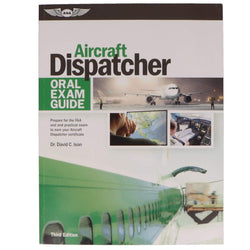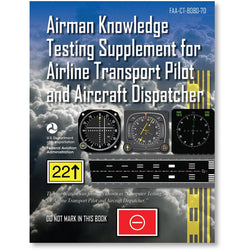 Do you have what it takes to thrive in a fast-paced aviation job where your actions and decisions can mean the difference between safety and tragedy for hundreds of people?
Do you have what it takes to thrive in a fast-paced aviation job where your actions and decisions can mean the difference between safety and tragedy for hundreds of people?
This time we’re not talking about pilot careers. Instead, today’s focus is on the people on the ground who oversee all those flights: air traffic controllers.
We will explore what the job entails, the process to become a controller, the pay, the schedule, and the qualifications (including an unexpected one that disqualifies many would-be controllers).
Is an air traffic control job the right fit for you or someone you know? It’s time to find out.
Table of Contents
- What Does an Air Traffic Controller Do?
- What Qualifications Do You Need to be an Air Traffic Controller?
- How Do I Start an Air Traffic Controller Career?
- How Much Do Air Traffic Controllers Make?
- How Many Hours Do Air Traffic Controllers Work?
- How Long Does it Take to be an Air Traffic Controller?
- Is it Hard to Become an Air Traffic Controller?
- Air Traffic Controller Age Requirements
 What Does an Air Traffic Controller Do?
What Does an Air Traffic Controller Do?
If you are a pilot, you’re already familiar with the general job description of an air traffic controller. These aviation industry professionals are responsible for monitoring and coordinating aircraft movements within their assigned sectors to maintain safe aircraft separation.
Depending on where the controller is stationed, they may be an en route controller handling flights in the air or a terminal controller dealing with takeoffs, landings, and aircraft within terminal airspace.
Let's further break down the tasks for ATC professionals.
-
Information for Pilots: Air traffic controllers provide important details, such as severe weather conditions along the flight path, any issues with the runway, and other essential information that is needed for a successful and secure operation.
-
Traffic Management: Air traffic controllers have the important responsibility of monitoring aircraft within specific airspace boundaries. As planes enter or exit these boundaries, controllers must ensure that control is seamlessly transferred to the appropriate personnel.
-
Airspace Monitoring: Air traffic controllers use advanced technology to oversee and manage the movement of aircraft through their designated Class airspaces. Through computer systems and visual monitors, they carefully monitor planes within their designated airspace.
The responsibilities are divided among different types of controllers, such as tower controllers who oversee ground traffic movements, approach and departure controllers who manage takeoffs and landings, and en route controllers who guide planes between airports. -
Pilot Guidance: Air traffic controllers provide guidance to pilots for flight operations. Pilots must radio in for clearance from controllers before taking off or landing their aircraft at designated locations.
-
Handle Emergencies: In the event of an emergency, air traffic controllers stick to very strict protocols. They quickly relay all important information to airport personnel, emergency services and other relevant parties, making sure that everyone is on the same page and can take appropriate action.
To be a great controller, you must have complex problem solving and decisive decision-making skills. The best controllers are also excellent at establishing and maintaining clear communication with pilots.
Pro Tip: Watch Business Insider’s mini ATC documentary on what it takes to be a controller at the busy Atlanta airport to get a good baseline understanding of the role.

What Qualifications Do You Need to be an Air Traffic Controller?
The Federal Aviation Administration's minimum requirements for prospective air traffic control specialists are:
-
Be a United States citizen
-
Be age 30 or under on the closing date of the application period (with limited exceptions)
-
Be registered for Selective Service, if applicable (required for males born after 12/31/1959)
-
Pass a medical examination
-
Pass a background check / security investigation
-
Pass the FAA air traffic pre-employment test
-
Speak English clearly enough to be understood over communications equipment
-
Have three years of progressively responsible work experience, or a bachelor’s degree, or a combination of post-secondary education and work experience that totals three years
-
Be willing to relocate to an FAA facility based on agency staffing needs
How Do I Start an Air Traffic Controller Career?
-
The first step to becoming an air traffic controller is to apply during one of the annual hiring windows. “Experienced hire” openings are posted at the beginning of the year and “off-the-street” hires for those without any aviation background open in the summer. The windows are usually only a few days long, so watch carefully and don’t miss it.
-
Once you apply, if your application for becoming an air traffic controller is being considered, you will be asked to take a biographical assessment (BA) which is essentially a pass/fail personality test that determines if you are a good fit for the position.
-
Applicants who pass the BA take the Air Traffic Skills Assessment exam (known as the AT-SA). The test is pass/fail, but a higher score will place you in a higher-ranked band, making you more likely to receive a job offer.
-
The candidates with the highest AT-SA scores will receive a temporary offer letter (TOL).
-
After you accept the TOL and turn it in to HR, you will move on to the clearance information letter (CIL). This letter contains the information you need to start obtaining your medical and security clearances. (The FAA is working to streamline this part of the onboarding process, but it may still take a while).
-
You need to obtain both your medical and security clearances before you can receive a firm offer letter (FOL). The medical includes an FAA Class II medical exam, drug screen, and Minnesota Multiphasic Personality Inventory Test (MMPI2). Security clearance processing takes months and includes filling out an online questionnaire and getting fingerprinted.
-
After HR receives your medical and security clearances, they can issue you a firm offer letter (FOL). If you have previous experience, you will get to create your facility preference rankings at this time. If you’re an off-the-street candidate, you will be given an academy start date.
-
Off-the-street hires need to pass their 3-to-6-month long FAA Academy to get placed in a facility and move into on-the-job training.
Once you make it through Academy, celebrate your new career with a Read Back Correct Limited Edition Sam Lyons Print showing controllers at work in the tower. It’s perfect for hanging in your aviation-themed family room.
How to Become an Air Traffic Controller Without a Degree
If you don't have a college degree, you may be wondering if you still qualify for an air traffic control position. Good news: Although a bachelor’s degree is one of the minimum requirements, there are two accepted alternatives for prospective air traffic controllers:
-
Three years of progressively responsible work experience -OR-
-
A combination of post-secondary education and work experience that totals three years
Note: Your work experience does not have to be in an aviation field.
Good Air Traffic Controller Soft Skills
- Math skills
- Communication skills
Pro Tip: Based on indeed.com’s research, due to the competitive nature of air traffic controller jobs, a degree from an Air Traffic Collegiate Training Initiative (AT-CTI) program is not only good preparation, but is also a way to stand out in the large crowd of entry-level trainee air traffic control specialist applicants.
How Much Do Air Traffic Controllers Make?
Air traffic controller jobs are challenging and stressful, but that complexity is reflected in the pay rates. The focus of this article is going to be the salary of Air Traffic Controllers based in the United States.
For the 2022 ATC trainee class, air traffic controller salaries started at $32,552 - $33,637 during FAA Academy training.
When the trainees completed FAA Academy and were assigned to on-the-job training at a facility, their annual salary bumped up to $41,101 plus any applicable locality pay.
Once trainees are fully certified, they will get another pay raise.
ATC specialists can qualify for a larger salary based on their facility location and the complexity of the airspace they manage.
For example, some places that air traffic controllers work can deal with substantially more flights than controllers at smaller regional airports, so the pay rates are higher in locations like Atlanta.
 How Many Hours Do Air Traffic Controllers Work?
How Many Hours Do Air Traffic Controllers Work?
The FAA says that most Air Traffic Control specialists (ATC) work full time and often some overtime. In large facilities that operate continuously, specialists rotate through night, day, and evening shifts. They also work weekends and holidays. At smaller facilities, control towers are only staffed from dawn to dusk.
Due to the intense levels of focus required, the FAA limits air traffic control shifts to a maximum of 10 hours. Most shifts are 8 hours long with mandatory breaks every 2 hours.
How Long Does it Take to be an Air Traffic Controller?
Once entry-level controller candidates are accepted to the program, the FAA says they need to “complete required training courses at the FAA Academy in Oklahoma City and gain on-the-job experience before becoming certified professional controllers.”
The timeline to go from a new hire starting at the academy to becoming a fully certified professional controller (CPC) usually ranges from 6 months to 5 years depending on the individual candidate’s background and where they are stationed.
Trainees at smaller VFR tower locations will be capable of solo work sooner than trainees at Centers or complex TRACONs. An aviation background can also shorten the necessary training time.
Pro Tip: Current air traffic controllers have shared that the process of taking the preliminary tests, passing the medical exams and security checks, plus getting scheduled for training usually takes a year from the time you apply, so don’t quit your current job when you get your initial ATC offer letter.
Is it Hard to Become an Air Traffic Controller?
The FAA Academy, or air traffic controller school, in Oklahoma City is a 3-month program for terminal candidates and 6 months for en route.
Former trainees have shared that the pass rate for academy is extremely low. Passing is not guaranteed, and sometimes the entire class fails. To pass the academy you need to speed a lot of time studying.
Air Traffic Controller Age Requirements
As you noticed in the above list, prospective controllers must be no older than 30 when they apply. This disqualifies and confuses many would-be candidates.
Why do air traffic controllers have to be under 31 years old? The reasoning behind this is that FAA safety regulations require controllers to stop working traffic at age 56, and to receive a federal pension, you need to have worked at least 25 years.
By making the maximum starting age cutoff 30, all new hire controllers have the potential to do their 25 years and earn a pension prior to reaching retirement age.
Pro Tip: The one publicly stated exception to the 30-year starting age cut off is for former military air traffic controllers. These candidates may apply even if they are older than 30.
Helpful Reads for Future Air Traffic Controllers [And Pilots Who Communicate With Them]
Enjoyed learning about how to find air traffic controller jobs? We've put together some guides to help improve those communication skills and increase general aviation knowledge.
It’s Your Turn
Are you an air traffic controller or do you know someone who is? We’d love to hear from you. What are the best parts of the job and which are the most challenging? If you could go back and do it all over, what advice would you give yourself? Would you still go into a career in air traffic control? Why or why not?









